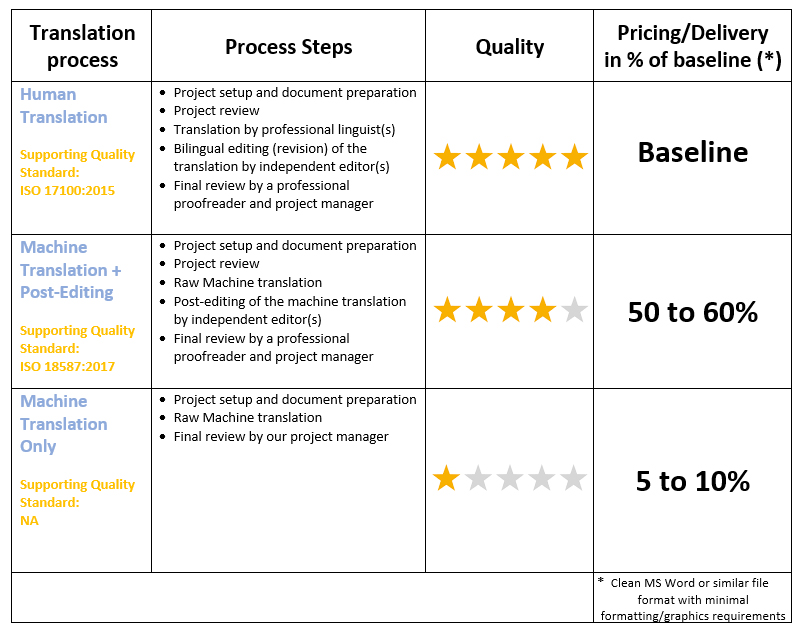The translation and language solutions industry has experienced substantial technological progress over the past 25 to 30 years. Indeed, it has shifted from relying primarily on manual processes to utilizing and benefitting from technological advancements in software tools and systems. The industry uses many terms today, from human translation or human-only translation to machine translation or raw machine translation, to AI-augmented translation or AI-generative translation.
For many Language Service Providers (LSPs), these technological enhancements mean it is no longer viable to solely offer “traditional” translation services performed by professional human linguists. Instead, these LSPs have recognized the ongoing developments of AI and its incorporation in language solutions through machine translation, or MT. Simply put, this is an automated process by which trained software translates one language (source language) into another (target language).
There are typically three approaches to document translation:
The first is the conventional approach: it involves professional linguists being the sole providers of translations. The second option is a hybrid approach, which deploys the skills and expertise of a linguist to manually revise a translation that was generated through AI, or machine-based translation. The third option involves generating translations by means of computer software. Let’s take a closer look at the three options in more detail below.
1. Human Translations – the Conventional Approach to Translations
The conventional approach to translations is based on the concept of “human translation”. This method involves a professional linguist or team of linguists to manually perform the translation. In addition, quality assurance analysts finalize the translation to produce a high-quality product. Translators must have strong linguistic skills in both the source language and the target language, as well as thorough understanding of the industry relating to the content.
In order to produce a high level of quality and accuracy, as well as match international standards, Language Service Providers should be compliant with industry-specific ISO standards, for example ISO 17100:2015. This certification is important for translation services because it guarantees the integrity of their work and provides assurance to their clients.
The ISO 17100:2015 quality standard requires several mandatory steps in the translation process:
- Project setup and document preparation
- Project review
- Translation by professional linguist(s)
- Bilingual editing (revision) of the translation by independent editor(s)
- Final review by a professional proofreader and project manager
Additionally, depending on project requirements, a Language Service Provider may provide the following services:
- Collaboration with client’s reviewer
- Terminology management
- Translation memory management
Human translations that follow ISO 17100:2015 quality standards will be of the highest quality and accuracy. However, when cost and/or turnaround time affect the decision process, alternative translation processes that use a different process may be more suitable for some projects. These options include the two types of machine translations below.
2. Machine Translation Plus Post-editing
The first step for this translation relies on, as its name indicates, machine translation. Today, this type of translation is called AI-augmented machine translation, or AI-generative machine translation. Then, the post-editing process involves having a professional linguist refine the machine translation results to make the translation more accurate and natural in the target language. The post-editor has the same qualifications as a linguist used for human translations described above. He or she corrects mistranslations, inconsistently translated terms, typos, omissions, grammar, and syntax issues in the machine translation output. This post-editing process ensures that the final translation is of much higher quality than the machine translation alone.
Post-editing has significant advantages over machine translation used on its own. For example, it greatly improves the accuracy of the translation, especially when dealing with complex texts. In addition, post-editing provides an opportunity to catch and fix the mistakes that will inevitably occur in machine translation. Of course, post-editing can be quicker than doing a full human translation since the translator does not have to start from scratch. This means that translations generated using this approach are typically delivered faster and at a lower cost.
Machine translation + post-editing is described in detail in the ISO quality standard 18587:2017 in order to produce an acceptable level of quality and accuracy. This certification is important for Language Service Providers, as it guarantees the integrity of their work and provides assurance to their clients.
The ISO 18587:2017 quality standard required the following steps:
- Project setup and document preparation
- Project review
- AI-augmented machine translation (also called AI-generative machine translation)
- Post-editing of the translation by independent editor(s)
- Final review by a professional proofreader and project manager
Depending on a project’s requirements, the following services are often available:
- Collaboration with client’s reviewer
- Terminology management
- Translation memory management
It is important to understand that the amount of time spent on post-editing can vary somewhat, depending on the project requirements, such as the final purpose of the translation, the complexity of the text, or turnaround time requirements. For this reason, there should be general agreement between the Language Service Provider and the customer to define this aspect.
Pricing for machine translation plus post-editing depends on several factors, such as the file format of the source documents, the complexity of text, language combination, localization of graphics, formatting requirements, etc. Assuming the source document is available in editable format, for example in MS Word, and has an average level of complexity in terms of layout, or graphic elements, the cost should be approximately 50-60% of a human-only translation. In addition, the turnaround time is also shorter, by about the same percentage margin.
3. Machine Translation Only (Raw Machine Translation)
AI-augmented machine translation only is a technology that produces translations directly from the source language to the target language. However, no professional linguist edits or reviews the translation at any step of the process. AI-generative translation can be useful when a quick translation is needed to get the gist of the original document, or when there are not enough resources available to produce an accurate, human-generated translation.
This type of raw machine translation consists of applying artificial intelligence and statistical techniques to produce a rough initial translation, using algorithms to identify linguistic patterns in the source text. This translation is typically valuable as a rough draft that would require additional human editing and refinement to reach an acceptable level of accuracy and quality. This approach can produce translations rather quickly, but its results aren’t always reliable. That is because the translations it produces often do not discern the context based on subject area, thus producing a translation with varying degrees of inaccuracies. For this reason, such a translation is usually not suitable for professional or business use. For example, since raw machine translation is not able to consider the cultural context of a phrase or sentence, it could produce results that are confusing, possibly even offensive.
The required steps to translate content using the machine translation approach are:
- Project setup and document preparation
- Raw machine translation
- Final review by the project manager
Pricing for raw machine translation depends on several factors, such as the file format of the source document, the complexity of the text, language pairs, presence of graphics localization, formatting requirements, etc. Assuming the source document is available in editable format, for example in MS Word, and has an average level of complexity in terms of layout, graphics, etc, the cost should be approximately 5-10% of a human-only translation. In addition, the turnaround time is also shorter, by about the same percentage margin.
The table below summarizes the process steps for these different translation approaches, and provides a relative comparison in terms of quality, cost, and delivery time.


